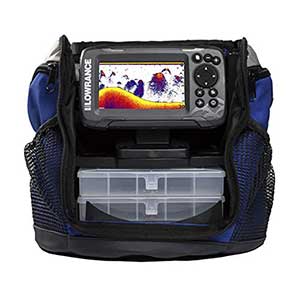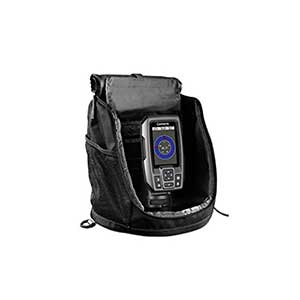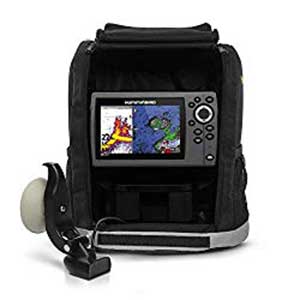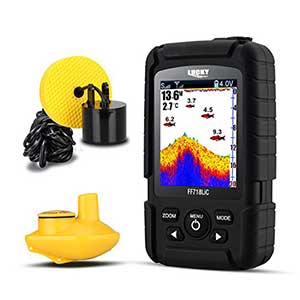Fish anywhere anytime with these quality portable and wireless fish finders.
If you are looking to improve your luck in fishing, buying a fish finder will really help. Portable fish finders are amazing little devices that can help you to catch more fish without wasting time. If you are an avid fisherman but don’t have a boat, then a portable device is a great option for you. These gadgets are also perfect for those who fish from kayaks.
In our opinion, the best portable fish finders for 2025 are:
- HOOK² Ice Fishing and All-Season Pack
- Garmin Striker 4 with Portable Kit
- Humminbird Helix 5 with Portable Kit
- LUCKY Fish Finder Wired & Wireless Portable
- Deeper Pro+ Smart Fish Finder
Depth Finders 101: These wonders of technology use sound waves to locate fish underwater. Basically, the device broadcasts sound waves into the water, which bounce back once they hit something and allows the fish finder to map the environment. This method works very accurately, and can really take your fishing to the next level.
Portable Fish Finder Reviews 2025
HOOK² Ice Fishing and All-Season Pack
The pack includes a HOOK² 4X Fish Finder, Two Transducers, Battery, Charger and Carry Case. This fish finder by Lowrance offers plenty of features and capabilities for a decent price. The first thing to note about it is how easy it is to use. Gadgets like this can often be very confusing at first, but with its phone-like menus, you will have the HOOK2 figured out in no time.
This device is not just simple though, it really delivers results. Featuring the beloved wide angle CHIRP sonar cone, you will get the most out of this fish finder. The sonar here will give you double the coverage of traditional devices. Included in the product is a Bullet Skimmer transducer. This transducer gives you the traditional 2-D CHIRP sonar (fish arch) views.
The single transducer here can easily be mounted on the transom, hull, trolling motor or through a scupper hole. This makes it the ideal fish finder for small boats, kayaks or canoes that have limited console space.
Beyond the fish finding capabilities, the unit has an effective GPS as well. This gives you basic navigation, and the ability to add waypoints and follow trails.
Brand
Lowrance
Sonar
Chirp
Display
4-inch horizontal display
Resolution
480 x 320 pixels
Ideal for
Shore, Lake, River
Main Features
- SolarMAX display with easy to use menus
- Impressive sonar coverage
- Versatile transducer
- GPS and waypoint abilities
What we like
- Very easy to use and set up
- Great sonar coverage with reliable results
- Comes with many great features available through the keypad
- Great with showing depth and water temperature
What we don't like
- Mapping not available on X models
Garmin Striker 4 with Portable Kit
While this Garmin fish finder is one of the more advanced units out there, it still manages to maintain a seriously easy to use system and interface. This Garmin Striker 4 with portable abilities is one of the best models available to those who take their fishing rather seriously. With all of its handy features and functions, you will be sure to catch more fish wherever you take it.
Of course, it has an amazing waypoint map which helps you to view, mark, and navigate to different locations such as brush piles, stumps and docks. The map function is a useful feature that can be applied in different ways. Not only does the device find fish, but it also points out hotspots to you. With this unit, you can easily mark and return to any particular spots, docks or ramps which you add to the map.
It comes with a portable carrying case which means you have space for cable storage, suction cup transducer mount and float. Not only is it simple to use but it’s ideal in a boat, kayak, canoe or even for ice fishing.
The Striker 4 includes a CHIRP (77/200 kHz) sonar transducer for optimal results. There is also transmit power of 200 W RMS/1600W peak-to-peak. If for some reason this is not enough for you, you can even take it to the next level by upgrading to a high-performance CHIRP. This will give you a GT8 or GT15 transducer.
This fish finder not only locates where the fish are, but combined with the awesome GPS and waypoint map, speed control tool, rechargeable battery, and an exceptionally clear CHIRP transducer, you will have the ultimate fishing tool.
Furthermore, with a highly sensitive GPS and a 3.5-inch colour screen, this device really gets the job done.
Product Specifications
Brand
Garmin
Sonar
Chirp
Display
Available in 3.5-, 5- and 7-inch display sizes
Resolution
480 x 320 pixels
Ideal for
Shore, Lake, River
Main Features
- Waypoint map and sensitive GPS
- Built-in flasher
- CHIRP Sonar
- Portable carrying case
What we like
- Easy to use and install
- Can mark specific locations and hotspots
- Great for all types of fishing
- Long lasting battery
- Built to last
What we don't like
- The transducer included is not specialised for ice fishing
Humminbird Helix 5 with Portable Kit
The Humminbird Portable Kit which in this instance includes the Helix 5 is a great solution for anyone looking for a mobile/portable fish finder setup. The kit can be paired with either the Helix 5 Series, Helix 7 Series, all the 100, 300, 500, 600 and 700 Series Humminbird fish finders so it’s a very versatile kit.
Includes: 9 Amp Hour gel -cell battery and wall charger.
Compatible with: HELIX 7 Series, HELIX 5 Series, all 100 Series, all 300 Series, all 500 Series, all 600 Series, alll 700 Series
Brand
Humminbird
Sonar
Side & Down imaging
Display
5″ Horizontal
Resolution
800 x 480 pixels, 256 color TFT display
Ideal for
Shore, Lake, River
What we like
What we don't like
LUCKY Fish Finder Wired & Wireless Portable
This device really lives up to its name as it will increase your chances of catching fish no matter the conditions or style of fishing. As one of the more budget-friendly portable fish finders out there, this gadget by LUCKY gives you a great range of features and settings that will help any fisherman. If you are looking for a fish finder that can be used in a variety of settings, then this option could be for you.
Featuring wired and wireless options, this is one of the most powerful castable products out there. It features an impressive depth capability of 328 feet with the cable, or 147 feet when wireless. When looking at the sonar coverage, it boasts 200 kHz with the cable and 125 kHz without it. This means that regardless of whether you choose wired or wireless, you will still have access to some serious capabilities.
The device has a floating and waterproof design so it can be trolled from any kayak or fishing boat. Also, it can be used continuously for 10 hours from a single charge and can handle both salt or freshwater.
Because it allows you to adjust its sensitivity, add or remove fish icons and alarms, and choose your scanning based on different fishing types, this gadget is as versatile as it is practical.
Brand
Lucky
Sonar
Side & Down imaging
Display
2.8″ Vertical
Resolution
3 color tone (Blue, Orange, Grey)
Ideal for
Shore, Lake, River
Main Features
- Wired and wireless options
- Comes with a floater and is waterproof
- Wireless operational range of 328 feet
- Rechargeable battery lasting 10 hours
- LCD colour screen
What we like
- Can adjust the sensitivity and choose between narrow to wide beam scanning
- Shows detailed depth data
- Can be cast an impressive distance
- Perfect for all fishing types
What we don't like
- Not very accurate in shallow water
Deeper Pro+ Smart Fish Finder
This portable fish finder works a little differently and is ideal for the casual angler who doesn’t need the vast amount of settings and features found in some of the other units out there. While this device comes in at a more affordable price and is very simple to use and operate, it does not lack performance though. It is a smart gadget that really works and is perfect for easy use on any fishing trip.
The Deeper Pro+ fish finder can be cast out onto the water. From there it generates its own wifi signal, meaning you will not need to use any mobile data or internet. Once on the water, you can connect to the device through your Deeper smartphone app. This super easy to use app will then show you where the fish are located, their depth and size, the water bottom contour and vegetation. Being able to easily access all of this info directly from your smartphone is seriously convenient.
The device itself can cast out to 165 feet and scans down to 165 feet from where it is. It boasts a 40° sonar beam which gives you total accuracy and coverage. Every scan from this beam is automatically saved with its time and location.
The unit has an automatic night fishing mode, it’s very lightweight for longer casting, and is ideally designed for easy reeling in. The rechargeable battery will last at least 6 hours so you will be sure to get a good long fishing session in with this device.
The size and weight of this gadget are seriously convenient, and because it connects to your smartphone app, portability is absolutely maximised. You really can take this little fish finder anywhere. For a product at this price and simplicity, it is a great tool for the everyday fisherman looking to up their game a notch.
Brand
Deeper
Sonar
Side & Down imaging/p>
Display
N/A – Smart Phone Required
Resolution
N/A
Ideal for
Shore, Lake, River
Main Features
- Wifi Connection
- Uses your phones GPS for mapping capabilities
- Small and lightweight
- Compatible with the Deeper smartphone app
What we like
- Very simple to use and understand data
- Easy to transport
- Casts and reels well
- The app still provides many useful fish finder features
What we don't like
- Can have connection difficulties
Types of portable fish finders
No matter what type of fishing you do, there is a portable fish finder solution for you. We have broken them down into 3 main types to make it easier for you to.
PORTABLE UNITS
This is a combination of a small fish finder unit along with a special portable kit consisting of carry case, mounts, portable transducer and a rechargeable 12v battery.
CASTABLE
This is a combination of a small fish finder unit along with a special portable kit consisting of carry case, mounts, portable transducer and a rechargeable 12v battery.
MOUNTABLE
Mountable fish finders can be easily attached to a small boat of kayak temporarily. This is great for travelers or anglers using rental boats.
Weight
When it comes to buying any portable device, weight is always an important consideration. As you will most likely be attaching your fish finder to a fishing kayak as dedicated kayak fish finders are becoming quite popular, carrying it around, and travelling with it on fishing trips, it is important that your device doesn’t weigh you down (this is also important if you go ice fishing and looking for an ice fishing fish finder).
Most of these units weigh in around 1 pound or less. If you are looking for the best fish finders for a larger boat, then weight may not be such an issue as these often have a specific mounting place. However, if you are planning on casting, reeling (using your favourite baitcasting reel, or Shimano spinning reel), trolling (trolling motors can weigh a LOT) or travelling with your fish finder, then consider its weight before making a purchase.
Cone Angle
Fish finders work using a part of the device called a transducer. The transducer is what generates the sound waves underneath the water. These sound waves are what pick up the objects and activities underwater, which ultimately show you where the fish are. Sound waves are cone-shaped.
The cone angle of your fish finder is, therefore, a highly important aspect of how well the device will work to find and identify fish. In short, the wider the degree of the cone is, the bigger the beam it generates. The bigger the beam means more visibility as to what is going on under the water.
Generally, a cone angle of 20° is perfect for fishing at a range of depths and settings. Some units come with dual frequency transducers which give you more options for coverage. These usually come with a 20° and 60° cone angle.
Be sure to know what kind of cone angle you will require for the type of fishing you plan on doing before purchasing your device.
Screen Resolution
While you won’t need your fish finders screen for watching movies or HD videos, it is still important to have a good pixel quality for better results, the same goes for the display of underwater fishing cameras. Pixels are the little dots which make up the image on your screen. The higher the number of pixels, the clearer and more detailed the image will be.
At a minimum, you should want a screen with 240 vertical pixels and 160 horizontal pixels. This will show you what you need. However, this can be improved for a better quality image. If you want a really good quality display, then look out for units with a high definition screen. These will provide you with the clearest images, data and numbers.
Some units use smartphone apps to work as the screen. These offer a great portable and high-quality option, so might not have to take off your favourite polarized fishing sunglasses. While having a bigger, high definition screen may be ideal for reading the images and data, it can also mean the device will be less portable. Finding a good balance between screen size, resolution and portability is important.
Portability
As we are talking about portable fish finders here, the extent to which you can carry them around is a huge factor when deciding on which product to buy. Depending on how much you will travel with it, where you will use it, what you will attach it to, and whether you will be using it from a wide range of settings, you must know how easy it will be to move around.
There are many different types of portable fish finders out there with specific uses. You can get castable devices which you attach to your line and cast out. You can also get GPS devices which are more advanced and most often used for ocean fishing.
Depending on your specific fishing situation and needs, it is important to know what level of portability you are after, and what exact type of unit you will require.
Waterproof?
Going fishing obviously means there will be water involved. Water and electronics don’t mix well. Therefore, knowing that your fish finder is waterproof is very important. While you may not be submerging your unit completely in water, it is still good to know that any splashes or rain against it won’t damage the device. As these can be quite costly pieces of equipment, you need to know that it is protected against water.
If you plan on fishing from a kayak or a situation where contact with water is very likely, make sure that your device will be well suited and protected.
Frequency
The sonar waves which are sent underwater to the transducer are what pick up the details on your fish finder. If you have a higher frequency, you will pick up on more details. However, this does not necessarily mean that higher frequency models are better. The situation that you prefer to fish in will determine this.
If you are in shallower water, then it will be best to use a device with higher frequencies. You ideally want this to be around 192 to 200 kHz. If you are going to be doing deep water fishing, then it would be best to opt for a device that uses lower frequencies. This should be around 50 kHz.
Power
The more watts your fish finder has, the faster it will display readings. Having a greater wattage will also allow you to use the device at a greater depth while maintaining accurate readings. If you will be using it in shallow freshwater, then the power is not as important. However, having the greatest amount of watts that you can on your device, will always be useful – especially if you plan on going deeper.
Of course, you will only be able to use your fish finder for as long as its power allows. Knowing how your fish finder is powered and how long it will last are important things to note before buying. The kind of power you require will depend on your situation. If you will be using the device often over long periods of time, and travelling with it – having a good reusable battery may be important.











